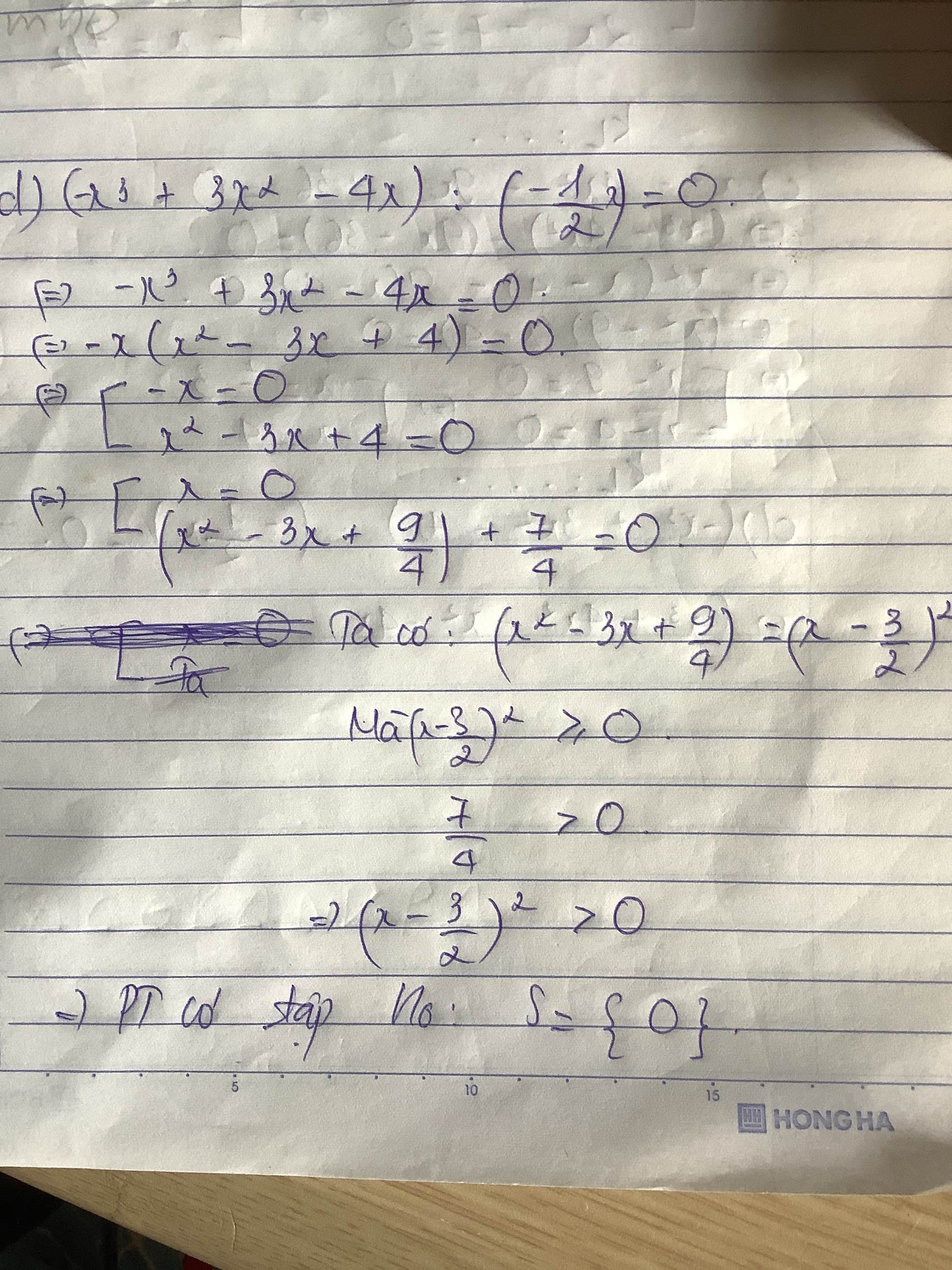cm pt vô nghiệm
a)x4 +x3 +1=0
b)x4+x+1=0

Những câu hỏi liên quan
Gọi x1 , x2 là nghiệm của pt x^2+2009x+1=0 và x3,x4 là nghiệm của pt x^2 +2010 +1=0
Tính giá trị biểu thức (x1+x3)(x2+x3)(x1-x4)(x2-x4)
giải phương trình:
a, x4-x2-2=0
b, x4+2x3+x2=0
c,x3-1= 0
d, 6x2-7x+2=0
a, \(x^4-x^2-2=0\Leftrightarrow x^4-2x^2+x^2-2=0\)
\(\Leftrightarrow x^2\left(x^2-2\right)+\left(x^2-2\right)=0\Leftrightarrow\left(x^2+1>0\right)\left(x^2-2\right)=0\Leftrightarrow x=\pm\sqrt{2}\)
b, \(\Leftrightarrow x^2\left(x^2+2x+1\right)=0\Leftrightarrow x^2\left(x+1\right)^2=0\Leftrightarrow x=0;x=-1\)
c, \(\Leftrightarrow\left(x-1\right)\left(x^2+x+1>0\right)=0\Leftrightarrow x=1\)
d, \(\Leftrightarrow6x^2-3x-4x+2=0\Leftrightarrow\left(3x-2\right)\left(2x-1\right)=0\Leftrightarrow x=\dfrac{2}{3};x=\dfrac{1}{2}\)
Đúng 2
Bình luận (0)
a)
/ \(x^4+x^2-2=0\)
\(\Leftrightarrow\left(x^2\right)^2-x^2+2x^2-2=0\\ \Leftrightarrow x^2\left(x^2-1\right)+2\left(x^2-1\right)=0\\ \Leftrightarrow\left(x^2+2\right)\left(x^2-1\right)=0\\ \Leftrightarrow\left(x^2+2\right)\left(x-1\right)\left(x+1\right)=0\\ \Leftrightarrow\left[{}\begin{matrix}x^2+2=0\\x+1=0\\x-1-0\end{matrix}\right.\Leftrightarrow\left[{}\begin{matrix}x=1\\x=-1\end{matrix}\right.\)
Đúng 0
Bình luận (0)
a) x3 + x2 + x + 1 = 0
b) x3 - 6x2 + 11x - 6 = 0
c) x3 - x2 - 21x + 45 = 0
d) x4 + 2x3 - 4x2 - 5x - 6 = 0
a) Ta có: \(x^3+x^2+x+1=0\)
\(\Leftrightarrow x^2\left(x+1\right)+\left(x+1\right)=0\)
\(\Leftrightarrow\left(x+1\right)\left(x^2+1\right)=0\)
mà \(x^2+1>0\forall x\)
nên x+1=0
hay x=-1
Vậy: S={-1}
b) Ta có: \(x^3-6x^2+11x-6=0\)
\(\Leftrightarrow x^3-x^2-5x^2+5x+6x-6=0\)
\(\Leftrightarrow x^2\left(x-1\right)-5x\left(x-1\right)+6\left(x-1\right)=0\)
\(\Leftrightarrow\left(x-1\right)\left(x^2-5x+6\right)=0\)
\(\Leftrightarrow\left(x-1\right)\left(x-2\right)\left(x-3\right)=0\)
\(\Leftrightarrow\left[{}\begin{matrix}x-1=0\\x-2=0\\x-3=0\end{matrix}\right.\Leftrightarrow\left[{}\begin{matrix}x=1\\x=2\\x=3\end{matrix}\right.\)
Vậy: S={1;2;3}
c) Ta có: \(x^3-x^2-21x+45=0\)
\(\Leftrightarrow x^3-3x^2+2x^2-6x-15x+45=0\)
\(\Leftrightarrow x^2\left(x-3\right)+2x\left(x-3\right)-15\left(x-3\right)=0\)
\(\Leftrightarrow\left(x-3\right)\left(x^2+2x-15\right)=0\)
\(\Leftrightarrow\left(x-3\right)\left(x^2+5x-3x-15\right)=0\)
\(\Leftrightarrow\left(x-3\right)^2\cdot\left(x+5\right)=0\)
\(\Leftrightarrow\left[{}\begin{matrix}x-3=0\\x+5=0\end{matrix}\right.\Leftrightarrow\left[{}\begin{matrix}x=3\\x=-5\end{matrix}\right.\)
Vậy: S={3;-5}
d) Ta có: \(x^4+2x^3-4x^2-5x-6=0\)
\(\Leftrightarrow x^4-2x^3+4x^3-8x^2+4x^2-8x+3x-6=0\)
\(\Leftrightarrow x^3\left(x-2\right)+4x^2\cdot\left(x-2\right)+4x\left(x-2\right)+3\left(x-2\right)=0\)
\(\Leftrightarrow\left(x-2\right)\left(x^3+4x^2+4x+3\right)=0\)
\(\Leftrightarrow\left(x-2\right)\left(x^3+3x^2+x^2+4x+3\right)=0\)
\(\Leftrightarrow\left(x-2\right)\left[x^2\left(x+3\right)+\left(x+1\right)\left(x+3\right)\right]=0\)
\(\Leftrightarrow\left(x-2\right)\left(x+3\right)\left(x^2+x+1\right)=0\)
mà \(x^2+x+1>0\forall x\)
nên (x-2)(x+3)=0
\(\Leftrightarrow\left[{}\begin{matrix}x-2=0\\x+3=0\end{matrix}\right.\Leftrightarrow\left[{}\begin{matrix}x=2\\x=-3\end{matrix}\right.\)
Vậy: S={2;-3}
Đúng 1
Bình luận (0)
Tìm x:
a) x4-25x3=0
b) (x-5)2-(3x-2)2=0
c) x3-4x2-9x+36=0
d) (-x3+3x2-4x) : (\(-\dfrac{1}{2}\)x)=0
a.
$x^4-25x^3=0$
$\Leftrightarrow x^3(x-25)=0$
\(\Leftrightarrow \left[\begin{matrix} x^3=0\\ x-25=0\end{matrix}\right.\Leftrightarrow \left[\begin{matrix} x=0\\ x=25\end{matrix}\right.\)
b.
$(x-5)^2-(3x-2)^2=0$
$\Leftrightarrow (x-5-3x+2)(x-5+3x-2)=0$
$\Leftrightarrow (-2x-3)(4x-7)=0$
\(\Leftrightarrow \left[\begin{matrix}
-2x-3=0\\
4x-7=0\end{matrix}\right.\Leftrightarrow \left[\begin{matrix}
x=\frac{-3}{2}\\
x=\frac{7}{4}\end{matrix}\right.\)
Đúng 1
Bình luận (0)
c.
$x^3-4x^2-9x+36=0$
$\Leftrightarrow x^2(x-4)-9(x-4)=0$
$\Leftrightarrow (x-4)(x^2-9)=0$
$\Leftrightarrow (x-4)(x-3)(x+3)=0$
\(\Leftrightarrow \left[\begin{matrix} x-4=0\\ x-3=0\\ x+3=0\end{matrix}\right.\Leftrightarrow \left[\begin{matrix} x=4\\ x=3\\ x=-3\end{matrix}\right.\)
d. ĐK: $x\neq 0$
$(-x^3+3x^2-4x):(\frac{-1}{2}x)=0$
$\Leftrightarrow x(-x^2+3x-4):(\frac{-1}{2}x)=0$
$\Leftrightarrow -2(-x^2+3x-4)=0$
$\Leftrightarrow x^2-3x+4=0$
$\Leftrightarrow (x-1,5)^2=-1,75< 0$ (vô lý)
Vậy pt vô nghiệm.
Đúng 1
Bình luận (0)
Xem thêm câu trả lời
1. Tìm \(m\in\left[-10;10\right]\) để pt \(\left(x^2-2x+m\right)^2-2x^2+3x-m=0\) có 4 ng pb
2. Cho biết x1,x2 là nghiệm của pt \(x^2-x+a=0\) và x3,x4 là nghiệm của pt \(x^2-4x+b=0\) . Biết rằng \(\dfrac{x2}{x1}=\dfrac{x3}{x2}=\dfrac{x4}{x3}\), b >0 . Tìm a
1.
Đặt \(x^2-2x+m=t\), phương trình trở thành \(t^2-2t+m=x\)
Ta có hệ \(\left\{{}\begin{matrix}x^2-2x+m=t\\t^2-2t+m=x\end{matrix}\right.\)
\(\Rightarrow\left(x-t\right)\left(x+t-1\right)=0\)
\(\Leftrightarrow\left[{}\begin{matrix}x=t\\x=1-t\end{matrix}\right.\)
\(\Leftrightarrow\left[{}\begin{matrix}x=x^2-2x+m\\x=1-x^2+2x-m\end{matrix}\right.\)
\(\Leftrightarrow\left[{}\begin{matrix}m=-x^2+3x\\m=-x^2+x+1\end{matrix}\right.\)
Phương trình hoành độ giao điểm của \(y=-x^2+x+1\) và \(y=-x^2+3x\):
\(-x^2+x+1=-x^2+3x\)
\(\Leftrightarrow x=\dfrac{1}{2}\Rightarrow y=\dfrac{5}{4}\)
Đồ thị hàm số \(y=-x^2+3x\) và \(y=-x^2+x+1\):
Dựa vào đồ thị, yêu cầu bài toán thỏa mãn khi \(m< \dfrac{5}{4}\)
Mà \(m\in\left[-10;10\right]\Rightarrow m\in[-10;\dfrac{5}{4})\)
Đúng 3
Bình luận (1)
\(x^4-2mx^2+2m-1=0 \) (1)
Tìm m để pt (1) có 4 nghiệm x1; x2 ;x3 ;x4 sao cho x1<x2<x3<x4 và x4 - x1= 3
a, Đặt x2=t(t≥0)x2=t(t≥0)
x4−2mx2+2m−1=0x4−2mx2+2m−1=0
⟺t2−2mt+2m−1=0⟺t2−2mt+2m−1=0 (**)
Để phương trình có 4 nghiệm phân biệt thì Δ′>0⟺m2−2m+1>0⟺(m−1)2>0⟺m≠1Δ′>0⟺m2−2m+1>0⟺(m−1)2>0⟺m≠1 (1)
Và {t1t2=2m−1>0t1+t2=2m>0 (∗){t1t2=2m−1>0t1+t2=2m>0 (∗)
⟺m>12⟺m>12 (2)
Phương trình bậc 4 trùng phương thì có 4 nghiệm trong đó có 2 cặp nghiệm là số đối của nhau.
Mà x1<x2<x3<x4→{x1=−x4x2=−x3x1<x2<x3<x4→{x1=−x4x2=−x3
x4−x3=x3−x2→x4=3x3x4−x3=x3−x2→x4=3x3
TT: x1=3x2x1=3x2
→x1.x4=9x2.x3→t1=9t2→x1.x4=9x2.x3→t1=9t2 ( với t1;t2t1;t2 là 2 nghiệm của pt(**))
Đến đây thay vào (*) bên trên ta được hệ:
⟺{9t22=2m−15t2=m⟺{9t22=2m−15t2=m
→9(2)2−25(1)⟺9m2−50m+25=0⟺(9m−5)(m−5)=0→9(2)2−25(1)⟺9m2−50m+25=0⟺(9m−5)(m−5)=0
⟺m=59⟺m=59 v m=5m=5 (cả 2 đều thỏa mãn)
∙∙ Với m=59⟺x=±1m=59⟺x=±1 v x=±13x=±13
∙∙ Với m=5⟺x=±1m=5⟺x=±1 v x=±3
Đúng 0
Bình luận (0)
tìm m để pt \(x^4-2\left(m+1\right)x^2+2m+1=0\) có 4 nghiệm phân biệt
thỏa mãna, x1<x2<x3<X4<3
b,x1-x3=x3-x2=x2-x1
\(x^4-1-2\left(m+1\right)x^2+2\left(m+1\right)=0\)
\(\Leftrightarrow\left(x^2-1\right)\left(x^2+1\right)-2\left(m+1\right)\left(x^2-1\right)=0\)
\(\Leftrightarrow\left(x^2-1\right)\left(x^2-2m-1\right)=0\)
\(\Leftrightarrow\left[{}\begin{matrix}x^2=1\\x^2=2m+1\end{matrix}\right.\)
Pt có 4 nghiệm pb khi: \(\left\{{}\begin{matrix}2m+1>0\\2m+1\ne1\end{matrix}\right.\) \(\Leftrightarrow\left\{{}\begin{matrix}m>-\dfrac{1}{2}\\m\ne0\end{matrix}\right.\)
Do \(x=\pm1< 3\) nên để \(x_1< x_2< x_3< x_4< 3\) thì:
\(\sqrt{2m+1}< 3\Leftrightarrow m< 4\) \(\Rightarrow\left\{{}\begin{matrix}-\dfrac{1}{2}< m< 4\\m\ne0\end{matrix}\right.\)
b. \(\left\{{}\begin{matrix}x_1-x_3=x_3-x_2\\x_1-x_3=x_2-x_1\end{matrix}\right.\) \(\Rightarrow\left\{{}\begin{matrix}x_1=-x_2\\x_1-x_3=-x_1-x_1\end{matrix}\right.\)
\(\Rightarrow\left\{{}\begin{matrix}x_2=-x_1\\x_3=3x_1\end{matrix}\right.\)
Do vai trò \(x_1;x_2\) như nhau, giả sử \(x_1< 0\) \(\Rightarrow x_1;x_3\) là 2 nghiệm âm
TH1: \(\left\{{}\begin{matrix}x_1=-1\\x_2=1\end{matrix}\right.\) \(\Rightarrow\left\{{}\begin{matrix}x_3=-\sqrt{2m+1}\\x_3=3x_1\end{matrix}\right.\) \(\Rightarrow-\sqrt{2m+1}=-3\Rightarrow m=4\)
TH2: \(x_1=-\sqrt{2m+1}\Rightarrow\left\{{}\begin{matrix}x_3=-1\\x_3=3x_1\end{matrix}\right.\) \(\Rightarrow-1=-3\sqrt{2m+1}\) \(\Rightarrow m=-\dfrac{4}{9}\)
Đúng 4
Bình luận (2)
Cho 2 phương trình : x^2-2x+a^2-1=0 (1) và x^2-2(a+1)x+a(a-1)=0 (2)
a) Tìm m để pt ( 2) có 2 nghiệm phân biệt
b) gọi x1,x2 là nghiệm của pt (1) va x3,x4 là nghiệm của pt (2) với x3<x4. tìm tất cả các giá trị của a để \(x_1,x_2\in\left(x_3;x_4\right)\)
Giả sử pt ax2+bx +c =0
Có 2 nghiệm x1,x2 dương.Cm rằng pt
cx2 + bx +a =0
Cũng có 2nghiệm x3,x4 dương. Cm rằng x1+x2+x3+x4 lớn hơn hoặc bằng 4
HELP ME
Theo định lý Viéte kết hợp với giả thiết ta có:
\(\left\{{}\begin{matrix}x_1+x_2=\frac{-b}{a}>0\\x_1x_2=\frac{c}{a}>0\end{matrix}\right.\)\(\Leftrightarrow\left\{{}\begin{matrix}ab< 0\\ac>0\end{matrix}\right.\)
Ta cần chứng minh: \(\left\{{}\begin{matrix}x_3+x_4=\frac{-b}{c}>0\\x_3x_4=\frac{a}{c}>0\end{matrix}\right.\)\(\Leftrightarrow\left\{{}\begin{matrix}bc< 0\\ac>0\end{matrix}\right.\) (*)
TH1: \(a>0\Leftrightarrow\left\{{}\begin{matrix}c>0\\b< 0\end{matrix}\right.\) \(\Leftrightarrow\) (*) luôn đúng
TH2: \(a< 0\Leftrightarrow\left\{{}\begin{matrix}c< 0\\b>0\end{matrix}\right.\) \(\Leftrightarrow\) (*) luôn đúng
Ta có đpcm.
Áp dụng BĐT Cauchy:
\(x_1+x_2+x_3+x_4\ge4\sqrt[4]{x_1x_2x_3x_4}=4\sqrt[4]{\frac{c}{a}\cdot\frac{a}{c}}=4\)
Dấu "=" xảy ra khi \(x_1=x_2=x_3=x_4\) \(\Leftrightarrow a=c\)
Đúng 0
Bình luận (0)
\(ax^2+bx+c=0\) (1) có 2 nghiệm dương \(\Leftrightarrow\left\{{}\begin{matrix}a\ne0\\\Delta=b^2-4ac\ge0\\x_1+x_2=-\frac{b}{a}>0\\x_1x_2=\frac{c}{a}>0\end{matrix}\right.\)
Xét \(cx^2+bx+a=0\) (2)
\(\Delta=b^2-4ac\ge0\Rightarrow\left(2\right)\) có 2 nghiệm
\(\left\{{}\begin{matrix}x_3+x_4=-\frac{b}{c}\\x_3x_4=\frac{a}{c}>0\end{matrix}\right.\)
Do \(\left\{{}\begin{matrix}-\frac{b}{a}>0\\\frac{c}{a}>0\end{matrix}\right.\) \(\Rightarrow\left(-\frac{b}{a}\right):\left(\frac{c}{a}\right)>0\Rightarrow-\frac{b}{c}>0\)
\(\Rightarrow\) (2) cũng có 2 nghiệm dương
Do \(\left\{{}\begin{matrix}-\frac{b}{a}>0\\\frac{c}{a}>0\end{matrix}\right.\) \(\Rightarrow a;c\) cùng dấu và trái dấu b
Ko mất tính tổng quát, giả sử \(a;c>0\) và \(b< 0\) ; đặt \(d=-b>0\)
\(\Rightarrow d^2\ge4ac\Rightarrow d\ge2\sqrt{ac}\)
\(A=x_1+x_2+x_3+x_4=-\frac{b}{a}-\frac{b}{c}=\frac{d}{a}+\frac{d}{c}=d\left(\frac{1}{a}+\frac{1}{c}\right)\)
\(A\ge2d\sqrt{\frac{1}{ac}}\ge2.2\sqrt{ac}.\sqrt{\frac{1}{ac}}=4\) (đpcm)
Dấu "=" xảy ra khi \(a=c=\frac{1}{2}d\) hay \(a=c=-\frac{1}{2}b\)
Đúng 1
Bình luận (0)


























